What’s an ambivert and am I one?
WORDS BY SIENNA BARTON
“Sure, knowing this information about yourself serves as a quirky conversation topic, but what are its practical applications?”
I’m the kind of person who dreads going to parties. Part of this is likely due to social anxiety, but I know that a lot of this is because I quite like my own company. I’ve been known to be a bit of a hermit. I laugh a lot at my own jokes and I enjoy having time and space to focus on my hobbies.
Oftentimes, to avoid attending a party, I’d lie and say that I’m sick with diarrhoea mostly because no one wants to ask any further questions about diarrhoea. A big part of my professional (and personal) growth has happened because I’ve ignored my impulse to stay at home alone, and forced myself to attend these parties.
Interested to hear how others navigate the world? Head to our Life section.
The wildest part of this game I play with myself is that I usually end up having a fantastic time once I’m at these parties. I love a good chat, and one of my coping mechanisms when I’m nervous is to overshare and tell self-deprecating jokes. So, while I may initially feel uncomfortable, I end up enjoying the social interaction. How could I be both an introvert and an extrovert at the same time? That didn’t make sense!
Thanks to my years spent working at organisations keen on new-age personal development questionnaires, I’m no stranger to the Myers-Briggs personality test. If you’re single, you’ve probably seen people share their scores in their online dating profile bios – they’re a bit like the “What’s your sign?” trend of the 2020s.
While I’m generally pretty sceptical about any sort of non-scientific method of describing a person’s attributes (like star signs, but I’m slowly coming around on those, too), I’ve taken the Myers-Briggs three times over the span of ten years and always received a score of INFJ-T. The ‘I’ in this garbled selection of letters stands for ‘introvert’, while the others are related to a mass of other personality attributes.
The exact numerical score has varied over the years, but I’ve always been roughly 5 to 9 per cent more introverted than I am extroverted. That’s all that stands between me being an extrovert, less than 10 per cent on the Myers-Briggs. I’ve never felt really more introverted or extroverted, so having a score somewhere in the middle made a lot of sense. But, I wondered, how could I have such a middle-of-the-road score and still be called an introvert? As it turns out, there’s a third category: ambiverts.
Introduced in the late 1970s by psychologist Dr Brian Little, ambiverts are described as people who exhibit both introverted and extroverted personality traits, or who fall somewhere in between these two extremes of the personality spectrum. Essentially, an ambivert is someone who has a balance of both extroverted and introverted tendencies. As I looked further into the characteristics of an ambivert, I continued to see myself represented.
According to Dr Little, ambiverts can enjoy socialising and being around people, but also need and enjoy their alone time. They’re described as having a preference for socialising in small groups or with close friends rather than at large gatherings or parties. ‘Well,’ I thought, ‘that sounds like me’. In his research, Dr Little found that people who fell in the middle of the introversion-extroversion spectrum tended to be more flexible and adaptable in social situations, and were able to draw on both introverted and extroverted traits as needed.
At first, I thought, ‘Hmmm, me? Adaptable? Unlikely!’ but then I gave it some more thought. It’s true, I vehemently dislike change but I’m pretty skilled at adapting to new situations (no matter how much I hate them).
Then I thought again about horoscopes and considered I might be falling victim to confirmation bias. I do wonder what the point is of labelling oneself an introvert, extrovert or ambivert. Sure, knowing this information about yourself serves as a quirky conversation topic, but what are its practical applications?
Firstly, this brand of personality psychology is often used in business management contexts to promote team building, as employees learn about each other’s social and learning modalities. With ambiverts, you might set up a short team meeting where they participate in group activities. The activities aspect feeds their need to socialise, but the short duration ensures their social batteries aren’t worn out.
Understanding your personality type can also be greatly helpful in your day-to-day life, too. Figuring out how you operate in social situations can be a powerful tool in practising self-care because you’re more attuned to your needs. You can identify which kinds of situations or lengths of time might be draining, and make accommodations accordingly. It can also help you to identify areas you might be struggling with and would like to work on.
I know I get really overwhelmed by the idea of attending big group events. Knowing that I’m (most likely) an ambivert, I know that I’m more likely to enjoy smaller group settings for shorter amounts of time than my extroverted brethren. I might go to a party and start by sidling up to my friends and stretching my comfort zone by introducing myself to one or two new people. After I’ve put in a good hour or two, I know it’s time for me to go home and unwind, and that’s okay. In fact, it’s probably what’s best for me.
For more on being an ambivert, try this.













